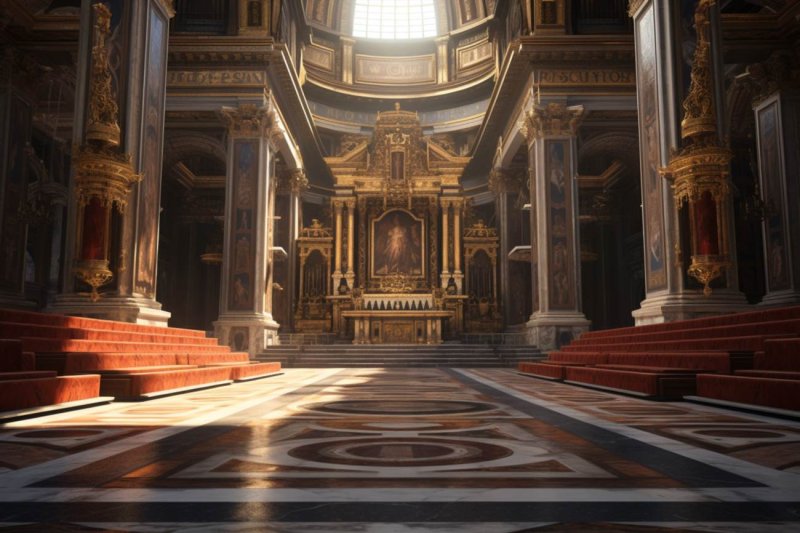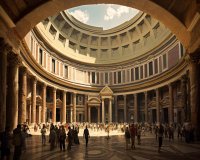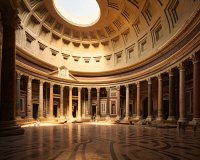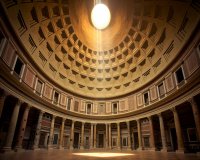From Temple to Church: The Evolution of the Pantheon

From Temple to Church: The Evolution of the Pantheon in Rome
The Pantheon in Rome stands as a testament to the architectural prowess and cultural significance of the Roman Empire. Over the centuries, this iconic structure underwent a profound transformation, transitioning from a pagan temple to a Christian church.
The Pagan Origins:
Built between 118 and 125 CE during the reign of Emperor Hadrian, the Pantheon was originally dedicated to the Roman gods. Its name, "Pantheon," is derived from the Greek words 'pan,' meaning all, and 'theos,' meaning gods, signifying its original purpose as a temple for all gods.
The most striking feature of the Pantheon is its massive dome, which was a groundbreaking architectural achievement of the time. It was constructed using a revolutionary technique that allowed for an oculus, or an open central skylight, providing both illumination and ventilation to the interior.
The Christian Transformation:
As the Roman Empire underwent a shift towards Christianity, the Pantheon's purpose began to evolve. In 608 CE, Pope Boniface IV consecrated the Pantheon as a Christian church, dedicated to St. Mary and the Martyrs. This transformation was symbolic of the triumph of Christianity over paganism in Rome.
Architectural Marvel:
The Pantheon's architectural brilliance continued to captivate observers even in its Christian incarnation. The dome, with a diameter of 43.3 meters, remained the largest of its kind in the world until the 15th century. The oculus, now a symbolic representation of the eye of God, continued to illuminate the church's interior with natural light.
Adaptations and Preservation:
Throughout the centuries, the Pantheon saw various modifications, including additions of altars and chapels. Despite these changes, the core structure and design remained intact. Its remarkable state of preservation can be attributed to its continuous use as a place of worship.
Legacy and Influence:
The Pantheon's architectural innovations had a profound influence on subsequent generations of architects. Its dome design, in particular, served as a model for countless other structures throughout history.
Conclusion:
The journey of the Pantheon from a polytheistic temple to a Christian church is a testament to the evolving cultural and religious landscape of Rome. Its enduring architectural brilliance continues to inspire awe and admiration, making it a true marvel of human ingenuity.
Explore the Pantheon with Skip-the-Line Access and Expert Guide
Discover the awe-inspiring Pantheon in Rome on a guided tour that includes skip-the-line access, allowing you to bypass long queues and delve into the historical depths of this remarkable architectural marvel.
Experience the Highlights
Marvel at the grandeur of the world's largest unreinforced concrete dome, accentuated by a magnificent oculus. Skip the wait with early access, granting you ample time to appreciate the fusion of Greek and Roman architectural elements. Admire the intricate mosaics, marble sculptures, and remarkable paintings that grace this ancient edifice, all while accompanied by a knowledgeable local tour guide.
Immerse Yourself in History
Embark on a journey through the rich history of the Pantheon as you meet your guide near the iconic elephant statue at Piazza della Minerva. Gain insights into the Pantheon's captivating past and be captivated by its colossal Corinthian columns and imposing dome. Inside, behold the celestial beauty of a ceiling adorned with golden stars and pay homage to luminaries such as Raphael, entombed within alongside Italian monarchs and artists.
Practical Information
Remember to dress modestly as the Pantheon is a church. This guided tour is conducted exclusively in English.
Book Your Pantheon Adventure
Secure your spot and embrace the splendor of the Pantheon with skip-the-line entry. Choose a date and save up to 12% on your booking. Make your reservation today and pay later, ensuring your travel plans remain flexible.
Additional Options
If you seek different ways to explore the Pantheon, consider these options:
- Pantheon Official Audio Guide: Explore at your pace with a fast track ticket and an optional audio guide.
- Pantheon Museum Guided Tour: Delve deeper with a guided tour through the Pantheon Museum, complemented by skip-the-line entry.
- Small-Group Pantheon Guided Tour: Enjoy an intimate experience with a small group, benefiting from skip-the-line privileges.
- Fast Track Pantheon Entry with Audio Guide App: Opt for an audio-guided visit with skip-the-line entry.
Reviews and Ratings
Based on 231 reviews, this guided tour of the Pantheon has received an outstanding overall rating of 4.9 out of 5, emphasizing its excellent value for money. Visitors have praised the knowledgeable guides, seamless organization, and the opportunity to delve into the captivating history and artistry of the Pantheon.
The Origins of the Pantheon as a Temple in Rome
The Pantheon in Rome is one of the most iconic and well-preserved ancient structures in the world. Its history is rich and fascinating, and its transformation from a pagan temple to a Christian church is a testament to the enduring legacy of this architectural marvel.
The Pantheon, whose name is derived from the Greek words "pan" (meaning all) and "theos" (meaning god), was initially commissioned by Marcus Agrippa, a Roman statesman and military leader, in 27 BC. The original purpose of the Pantheon was to serve as a temple dedicated to the gods of ancient Rome. However, the structure we see today is not the one Agrippa built, but rather a reconstruction that took place under the rule of Emperor Hadrian around 126 AD.
Hadrian's Pantheon was a grand architectural masterpiece, characterized by its distinctive dome, which was the largest in the world for centuries. The dome's construction was an engineering marvel, featuring a series of decreasing concrete rings that lightened the load as it ascended. The oculus, a central opening at the top of the dome, allowed sunlight and rain to enter the building, creating an ever-changing atmosphere within.
The Pantheon was dedicated to a range of gods, and their statues adorned the niches within the structure. The original bronze ceiling and interior were said to be resplendent with gold and other precious materials, adding to its grandeur. The Pantheon, as a temple, served both a religious and a political purpose, symbolizing the power and piety of the Roman Empire.
With the rise of Christianity in the Roman Empire, the purpose of the Pantheon began to evolve. In 609 AD, Pope Boniface IV consecrated the Pantheon as a Christian church, dedicating it to St. Mary and the Martyrs. This transition from a pagan temple to a Christian church allowed the Pantheon to survive the destructive waves of religious intolerance that swept through Rome.
Despite this transformation, the Pantheon's architectural significance remained intact. It continued to inspire architects and builders throughout the centuries, and its dome became a model for Renaissance and Baroque architecture. Even today, the Pantheon's dome remains a marvel of engineering and design.
Throughout its long history, the Pantheon has witnessed numerous restorations and modifications, but its fundamental structure has endured. The building stands as a testament to the enduring power of great architecture and the ability of cultural and religious shifts to repurpose and preserve ancient treasures.
The Pantheon's Legacy
The Pantheon's journey from a pagan temple to a Christian church represents a microcosm of Rome's broader transition from paganism to Christianity. It is a symbol of the city's ability to adapt and integrate its ancient heritage with the changing religious and cultural landscape.
Today, the Pantheon stands as a must-visit destination for tourists and a place of worship for Christians. It serves as a reminder of Rome's rich history and its ability to embrace diverse traditions while preserving its architectural and cultural heritage. The Pantheon's iconic dome, still marvelously intact, continues to inspire architects and visitors alike, leaving an indelible mark on the eternal city of Rome.
Rome: Spanish Steps, Trevi, Navona & Pantheon Tour at the Sunset
Discover Rome’s ancient monuments at the sunset with a local guide. Explore landmarks like the Spanish Steps, Trevi Fountain, and Pantheon in the afternoon, without crowds and in all its glory.
About this activity
Free cancellation. Cancel up to 24 hours in advance for a full refund. Reserve now & pay later. Keep your travel plans flexible — book your spot and pay nothing today. Special health and safety measures are in place. Check your activity voucher once you book for full details. Duration: 2 hours. Check availability to see starting times.
Live tour guide
English
Wheelchair accessible
Small group
Limited to 10 participants
Experience Highlights
- Enjoy amazing Rome’s top attractions
- Join us for a 2-hours walking tour with top-rated, licensed English speaking Guide
- Limited up to 10 people, tour ensures you a semi-private sightseeing experience
- Admire Roman highlights: Spanish Steps, Trevi Fountain, Pantheon and Piazza Navona
Full description
Rome’s ancient monuments come to life when illuminated after dark... Exploring Rome with our guide is one of the best ways to enjoy the Eternal City - it allows you to see the Roman capital without crowds and there’s simply something magical about seeing Rome lit up in all its glory. Join our licensed, English-speaking guide for a 2-hours walking tour to see amazing Rome’s top attractions lit up. Starting the tour in Piazza di Spagna, the guide will make history come alive showing you the Spanish Steps and describing the beauty of the most famous fountain in the world - Fontana di Trevi. Remember, that according to the legend, tossing one coin into the Trevi Fountain means you'll return to Rome!) The guide will show you the majesty of the Pantheon (from the outside) finally leading you through charming streets towards the most beautiful Roman square - Piazza Navona with its amazing, baroque Fountain of the Four Rivers created by Gian Lorenzo Bernini. Join us for this unique tour and experience the magic of Rome! Limited up to 10 people, the tour ensures you a semi-private sightseeing experience.
Includes
2-hours walking tour to see the most amazing Rome’s top attractions: Spanish Steps, Trevi Fountain, Pantheon, Piazza Navona, and more. Licensed, top-rated, English speaking guide.
Meeting point
The guide Ruggero will meet you in Piazza di San Simeone, next to the fountain. Open in Google Maps.
Save up to 30%
From $46.42 $32.50 per person
The Transformation of the Pantheon into a Church in Rome
The Pantheon, one of Rome's most iconic landmarks, has a rich history that spans nearly two millennia. Originally built as a temple to the Roman gods, it underwent a significant transformation that turned it into a Christian church, reflecting the changing religious landscape of Rome and the broader Roman Empire.
The Pantheon's construction began in 27 BC under the orders of Marcus Agrippa, a Roman statesman and general. However, the structure we see today owes much of its design to Emperor Hadrian, who oversaw its reconstruction around 126 AD. The building was dedicated to the traditional Roman gods, with its name "Pantheon" meaning "All the Gods" in Greek.
The Pantheon's most remarkable feature is its dome, which was an architectural marvel of its time. The dome's perfect proportions and the oculus, a circular opening at its center, allowed natural light to flood the interior. This architectural innovation still amazes visitors today and has inspired countless architects throughout history.
As the centuries passed, the religious landscape of Rome changed dramatically. The Roman Empire officially adopted Christianity in the 4th century AD under Emperor Constantine, leading to the widespread conversion of the population. Pagan temples, including the Pantheon, began to lose their significance.
The pivotal moment in the Pantheon's transformation came in 609 AD when Pope Boniface IV consecrated it as a Christian church, dedicating it to St. Mary and the Martyrs. This transition from a pagan temple to a Christian church marked a profound shift in the city's religious life.
The interior of the Pantheon was adapted to its new Christian purpose. Altars and Christian iconography were installed, and the statues of pagan gods were removed or replaced. Despite these changes, the breathtaking dome remained largely untouched, a testament to the enduring brilliance of Roman engineering.
Over the centuries, the Pantheon continued to be used as a church, and it played a significant role in various papal ceremonies. Its architectural significance also led to its preservation, making it one of the best-preserved ancient Roman buildings in the world.
Today, the Pantheon stands as a unique blend of ancient Roman engineering and Christian spirituality. Visitors from around the globe marvel at its beauty and history, and it remains a symbol of Rome's enduring cultural and religious heritage.
In conclusion, the transformation of the Pantheon into a Christian church reflects the evolution of Rome's religious identity over the centuries. This remarkable architectural wonder has stood the test of time, serving as a bridge between the pagan past and the Christian present, and continues to inspire awe and admiration in all who visit it.






